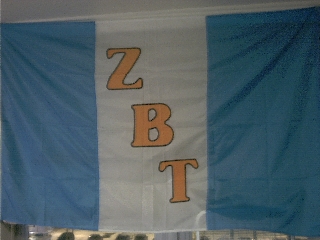|
The History of Zeta Beta
Tau:

Zeta Beta Tau Fraternity was
inspired by Richard J. H. Gottheil, a professor of languages at Columbia
University and a leader in the early American Zionist movement. On
December 29, 1898, Professor Gottheil gathered together a group of Jewish
students from several New York City universities to form a Zionist youth
society. The society was called ZBT.
During this brief period, the society came to serve as a kind of fraternal
body for college who, students as Jews, were excluded from joining
existing fraternities because of the sectarian practices which prevailed
at the end of the nineteenth century in the United States. The continuing
need for a Greek-letter fraternity open to Jewish students prompted ZBT.
to change its raison d'etre, structure and emphasis and to become Zeta
Beta Tau in 1903.
Zeta Beta Tau expanded rapidly. By 1909, it had established 13 Chapters
throughout the Northeast and a 14th at Tulane University at New Orleans,
thereby taking on a truly national dimension. In 1913, it established its
first Canadian Chapter at McGill University in Montreal. Five years later,
it founded its first West Coast Chapter at the University of Southern
California in Los Angeles. At the 1954 National Convention, the delegates
amended Zeta Beta Tau's Constitution, ritual and internal procedures both
in theory and in practice to eliminate sectarianism as a qualification for
membership.
Spearheaded by the growth of state and municipal university systems,
hundreds of new institutions were opened in the quarter-century following
World War II. By the 1960's virtually every American had an opportunity to
attend college. From 1945 to 1969, the number of ZBT chapters increased
from 30 to 80 units.
The history of mergers in the Zeta Beta Tau Brotherhood followed a pattern
of linking common traditions. In 1959, Phi Alpha merged into Phi Sigma
Delta, and in 1961 Kappa Nu merged into Phi Epsilon Pi. In 1969-70, Phi
Sigma Delta and Phi Epsilon Pi merged into Zeta Beta Tau.
Traumatic experiences were generated by the polarization over the Vietnam
conflict. The American fraternity system - including Zeta Beta Tau, was
subsequently affected by the great wave of anti-establishment feeling that
was pervasive throughout the country. Many of the Chapters which survived
this period of turmoil did so in a weakened condition. During the late
1970's and the early 1980's, there was a renewed interest in fraternity
life, resulting in increased initiation statistics, revival of many
dormant Chapters and expansion to new campuses.
During the 1980's, every Greek-letter group continued their efforts to
stop hazing. Despite ZBT's best efforts, hazing continued and increased in
frequency and severity. ZBT concluded that all efforts to reform the
institution of pledging had failed; pledging was the problem. This was
because pledges were considered second-class citizens, with no rights and
no chance to refuse even the most outrageous demands of a Brother, unless
he quit the Fraternity. In 1989, in a last-ditch effort to eliminate
hazing, ZBT eliminated pledging and all second-class status from the
Fraternity. In its place, ZBT established a Brotherhood Program, with
minimum standards (Brotherhood Quality Standards), as well as programs of
education, bonding, and earning one's Brotherhood status that applied to
all Brothers of ZBT.
Today, the merged Zeta Beta Tau Brotherhood is some 110,000 Brothers
strong, and ZBT Chapters and Colonies are established at over 80 campus
locations. Through good times and bad, ZBT has been in the forefront in
pioneering new concepts - as evidenced by its very founding, its
elimination of sectarian membership practices, its acceptance of mergers,
its elimination of pledging, and its ability to solve enormous problems
when others abandoned the effort.
ZBT continues to maintain a tradition of leadership and respect in the
interfraternity world.
|
